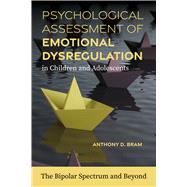
Psychological Assessment of Emotional Dysregulation in Children and Adolescents The Bipolar Spectrum and Beyond
by Bram, Anthony D.-

Free Shipping On Orders Over $35
Your order must be $35 or more to qualify for free economy shipping. Marketplace items, eBooks and apparel do not qualify towards the $35 purchase minimum.
-
 eCampus.com Device Compatibility Matrix
eCampus.com Device Compatibility Matrix
Click the device icon to install or view instructions
Buy New
Rent Textbook
Rent Digital
Used Textbook
We're Sorry
Sold Out
How Marketplace Works:
- This item is offered by an independent seller and not shipped from our warehouse
- Item details like edition and cover design may differ from our description; see seller's comments before ordering.
- Sellers much confirm and ship within two business days; otherwise, the order will be cancelled and refunded.
- Marketplace purchases cannot be returned to eCampus.com. Contact the seller directly for inquiries; if no response within two days, contact customer service.
- Additional shipping costs apply to Marketplace purchases. Review shipping costs at checkout.
Summary
As referrals for clinical assessment of complex children and adolescents frequently involve questions about emotional regulation in general and the possibility of bipolar spectrum conditions in particular, trainees and practitioners will find this to be an invaluable resource. Challenges with emotional regulation are common among patients of all ages who are referred for formal psychological assessment. Understanding the nature and severity of such challenges is crucial if evaluators are to make accurate formulations and develop meaningful treatment implications. This book will illuminate the process by which an assessment psychologist evaluates and reports the nature of emotional dysregulation. It will also serve as a reference book to tailor test batteries, interpret findings related to differential diagnosis, and link test findings with meaningful treatment implications.
Topics explored include detailed case examples addressing real-world referral questions, challenges around differential diagnosis, and explanations of treatment implications. Discussion of various assessment measures are considered as well, including more common measures like BASC-3 and performance-based measures as well as disorder-specific measures which may be less familiar to many clinicians. Providers will learn how to differentiate bipolar disorders from other co-occuring mental health disorders that feature dysregulated emotion, including OCD, PTSD, ADHD, and others.
Author Biography
Table of Contents
Part 1: Basic Considerations
Chapter 1. Emotional Regulation and Dysregulation in Children and Adolescents—What are We Assessing?
Chapter 2. Emotional Dysregulation, the Bipolar Spectrum, and Assessment Considerations with Children and Adolescents
Part II: Multimethod Assessment of Emotional Dysregulation Including Bipolar Spectrum Conditions
Chapter 3. Basic Rationale for and Principles of Multimethod Assessment
Chapter 4. Collateral-Report Measures to Assess Emotional Regulation
Chapter 5. Self-Report Measures to Assess Emotional Regulation
Chapter 6. Performance-Based Measures and Methods to Assess Emotional Regulation
Part III: Emotional Dysregulation, the Bipolar Spectrum, and Children and Adolescents: Considerations for DSM-5-TR Differential Diagnoses and Co-Occurring Conditions
Chapter 7. Orienting to Differential Diagnosis Within and Beyond the Bipolar Spectrum
Chapter 8. Either/Or: Diagnoses Mutually Exclusive with the Bipolar Spectrum
Chapter 9. And/Or: Conditions to Differentiate from the Bipolar Spectrum or that Co-Occur
Chapter 10. Conditions More Readily Differentiated from the Bipolar Spectrum But Potentially Co-occurring
Part IV: Treatment Implications and Other Considerations for Follow-up
Chapter 11. Treatment Implications: Elements to Consider
Chapter 12. Level of Care
Chapter 13. Treatment Modalities
Chapter 14. Factors Impacting Therapeutic Engagement and Collaboration
Chapter 15. Implications for School
Chapter 16. Additional Considerations for Follow-up Evaluation and Treatment Adjuncts
Part V: Case Illustrations
Chapter 17. Case 1: Denny
Chapter 18. Case 2: Stevie
Chapter 19. Case 3: Jillian
Chapter 20. Case 4: Nicole
Chapter 21. Case 5: Pedro
Chapter 22. Commentary on Cases and Concluding Thoughts
References
Index
An electronic version of this book is available through VitalSource.
This book is viewable on PC, Mac, iPhone, iPad, iPod Touch, and most smartphones.
By purchasing, you will be able to view this book online, as well as download it, for the chosen number of days.
Digital License
You are licensing a digital product for a set duration. Durations are set forth in the product description, with "Lifetime" typically meaning five (5) years of online access and permanent download to a supported device. All licenses are non-transferable.
More details can be found here.
A downloadable version of this book is available through the eCampus Reader or compatible Adobe readers.
Applications are available on iOS, Android, PC, Mac, and Windows Mobile platforms.
Please view the compatibility matrix prior to purchase.

